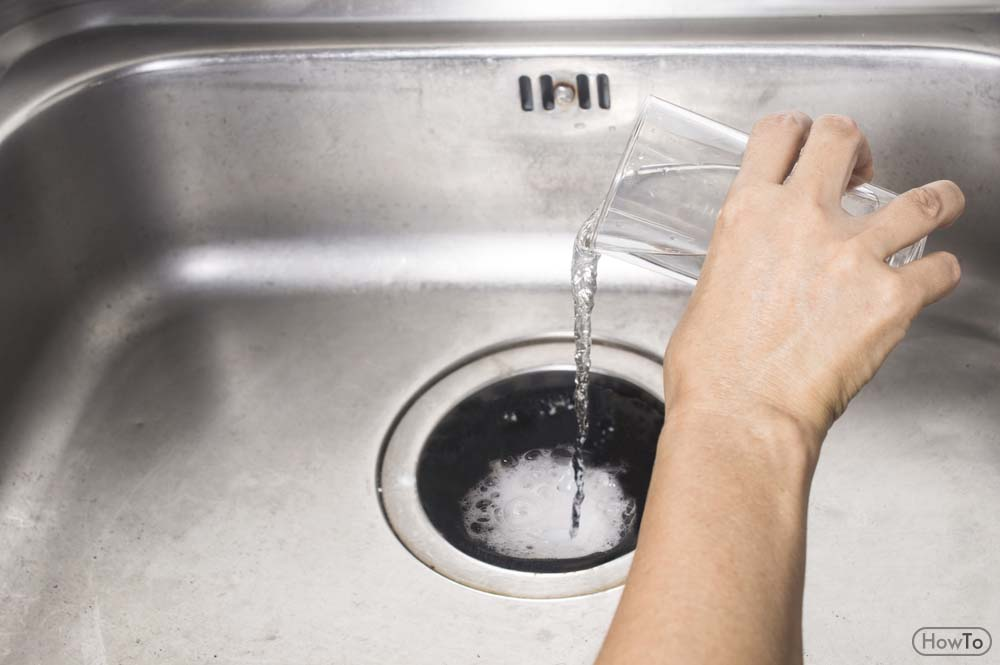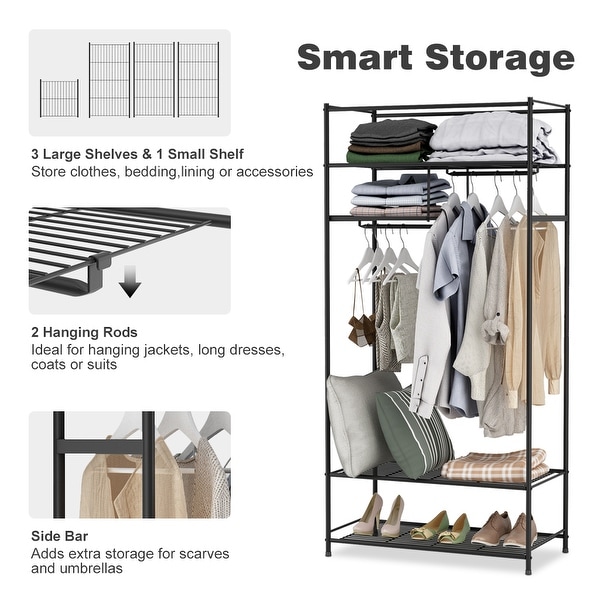Clogged kitchen drains
Kitchen sink not draining? Here are 6 ways to unclog it
There I was, minding my own business, washing the dishes after dinner like I always do. Just moments into scrubbing and rinsing the frying pan, I noticed that the water wasn't draining from the sink. I checked to see if anything was blocking the drain opening - nothing. I switched on the garbage disposal, but that was only a temporary fix. As I continued washing dishes, the drainage was only getting slower. With a clogged sink on my hands, my after-dinner cleanup was about to get more intense.
I'm sure I'm not the only one to experience the inconvenience of clogged drains. Clogged kitchen sinks are among the most common drainage issues to plague homeowners, largely because food debris and soap residue are nightmares for smooth draining. Thankfully, clogged drains are also one of the easiest home repairs to make on your own. However, before you roll up your sleeves and get into the do-it-yourself spirit, make sure you're aware of the plumbing myths that could lead you astray.
When it comes to the kitchen sink, for instance, don't think Drano and other chemical-based drain cleaners are the easy, go-to fix. The chemicals can sometimes cause more damage to your system, even if the clog seems fixed initially. Plus, backsplash from stubborn blockages could seriously harm your skin and eyes. You can avoid these catastrophes with other clog repair methods, some using common household items and others requiring some straightforward plunger or plumber's snake action.
Don't call the plumber yet! There's a good chance you can fix the problem yourself with one of these six methods to unclog a kitchen sink:
1. Attack with boiling water
When hair, grease, soap residue and other debris get stuck in your drain, boiling water may be all your pipes needs to loosen the blockage. It's the simplest fix, which means it should be your first move when trying to unclog a sink.
Easy as 1-2-3, here are the steps to follow:
- Bring half a gallon of water to a boil on your stove or use a kettle to heat the water.

- Pour the boiling water directly into the drain opening.
- Turn on the faucet to see if the water drains in a steady fashion. If it's still draining slowly or standing still in the sink, repeat the process.
Important note: Don't try this method if your drain is attached to PVC pipes, as the boiling water could melt or damage the plastic.
If the boiling water fails to dislodge the clog after the second try, it's time to move on to another method. Unfortunately, you have yourself a sink clog that's too stubborn for the simple boiling water approach.
2. Check the garbage disposal
If your sink has a garbage disposal, it could be the culprit of your drainage issues. If the clog is in the disposal, turning it on will usually break up the blockage. Overheated or dysfunctional disposals may not even turn on, but you can activate the reset switch at the side or bottom of the unit for an easy reboot. After resetting the disposal, try turning it on again to clear the clog.
If you turn on the disposal and hear a low humming sound, the unit could be jammed or broken. Before doing anything to fix your disposal, remember to disconnect the power to the unit and never - and we mean never - stick your hand in the disposal. From there, you can try to break up the clog in the disposal by turning the blades manually. You can do that by inserting an Allen wrench into the hole on the bottom of the disposal, and twisting until you feel less resistance, meaning the blockage is beginning to break up. If that doesn't work, follow these tips to unclog your garbage disposal. Once unclogged, turn the power back on and test the disposal. If all looks and sounds good, turn the faucet to see if the sink drainage is back to normal.
Keep in mind that your garbage disposal inspection may not reveal any clogs or issues, in which case you can skip straight to a different unclogging method.
3. Plunge away the blockage
Once you establish that the disposal isn't the problem, it's time to bring out the plunger.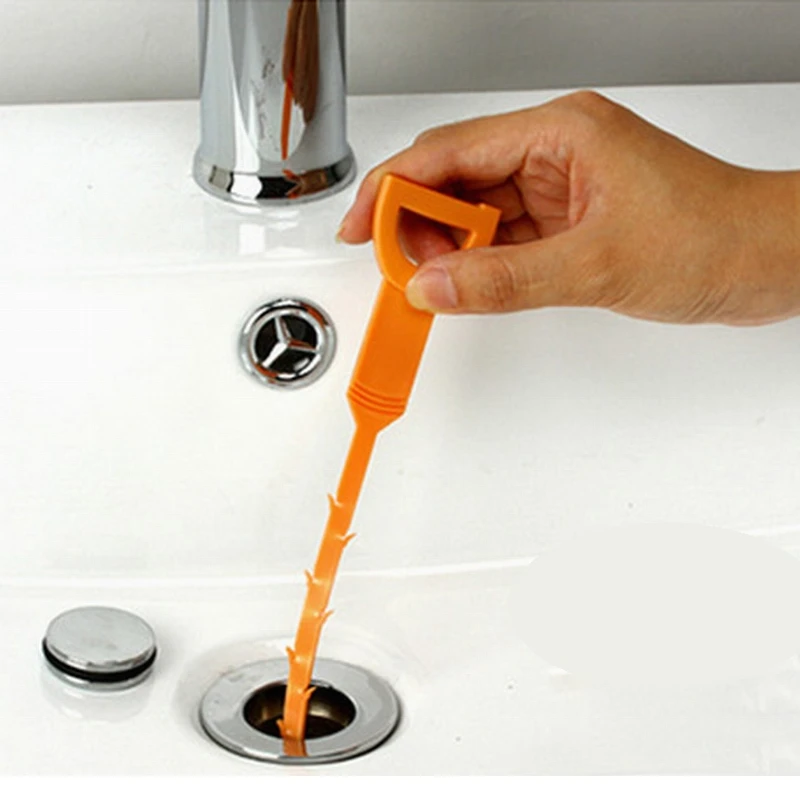 But keep in mind: While you can use the toilet plunger if it's all you have on hand, Dengarden suggested using a flat-bottomed one for the job. With your plunger at the ready, follow these steps:
But keep in mind: While you can use the toilet plunger if it's all you have on hand, Dengarden suggested using a flat-bottomed one for the job. With your plunger at the ready, follow these steps:
- Fill the sink with hot water until it's about halfway full and creates a seal around the drain.
- Position the plunger over the drain and begin pumping up and down quickly several times.
- Remove the plunger and wait to see if the water drains.
- Repeat the process until the water drains freely.
If the sink still isn't draining properly after multiple plunging attempts, you know the drill. Time to try a different method.
4. Break it down with baking soda and vinegar
This approach is a natural alternative to using chemical drain cleaners on clogged drains. Much to your convenience, baking soda and vinegar are also common household items that you're likely to already have in your kitchen. Follow these steps to let the mixture work its magic:
- Remove standing water from the sink with a cup or bowl.

- Pour one cup of baking soda down the drain, using a spatula or spoon to push the powder down the drain if necessary.
- Pour one cup of white vinegar down the drain opening.
- Place a stopper or cover on the drain to seal the opening.
- Let the mixture sit for 15 minutes.
- Remove the cover and run hot tap water down the drain.
- Use boiling water to break up more intense clogs.
As with any unclogging method, this natural alternative doesn't have a 100% success rate. However, if it seems like you're making progress on the clog after completing the steps, repeat the process to double down on the blockage.
5. Try the plumber's snake
The clogs that put up a fight will require the strength of a plumber's snake to battle the blockage. The tool has a coiled spiral snake that reaches down into the drain. Once the snake hits an obstruction, you can crank the handle to dislodge the debris and pull it out of the drain. Electric snakes pack even more power to tackle clogged drains.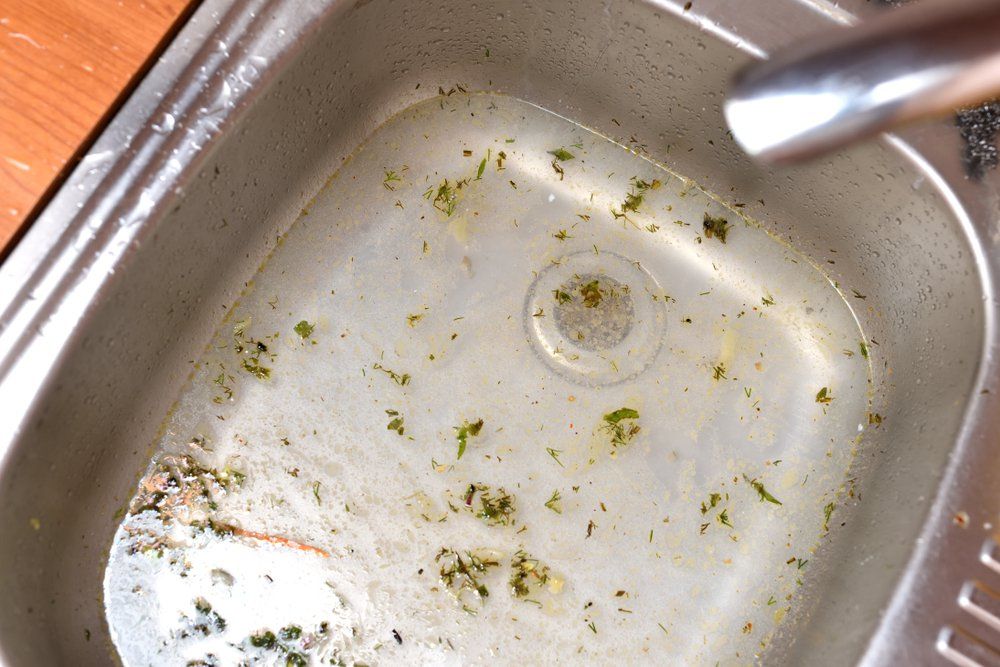
If you don't have a plumber's snake, you can create a makeshift one with a wire coat hanger. Simply use a pair of needle-nose pliers to unwind the hanger into a long piece of wire. Keep the hooked end, as this is what you'll use to grab onto the debris. If necessary, you can use the pliers to adjust the angle of the hook so that it can easily fit through the drain opening.
No matter which tool you're using, simply feed it down the drain a few feet at a time. Try not to push too roughly, as you might accidentally push the clog further down the pipe. When you feel the tip of your tool hit an obstruction, hook it on and pull the debris up through the drain. Keep doing this until you feel confident that the blockage is gone. Run hot water down the drain to see if you're right.
6. Clean the P-trap
If the water is still not draining correctly, there might be a blockage in the P-trap, aka the elbow-shaped pipe under your sink. Food, grease and other debris may be stuck in the pipe, causing your sink to drain slowly or not at all because the water hits a snag on its way down.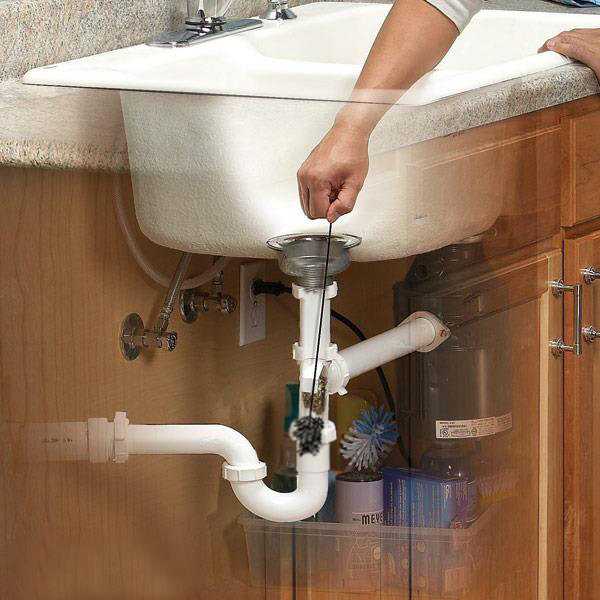
The fix is disassembling the pipe to clean out the gunk that's causing the blockage. Warning: This task can get a little messy, so you might want to prepare yourself with gloves, goggles and towels. When you're ready, follow these steps to clean the P-trap:
- Place a bucket underneath the pipe. This will catch any backed up water or debris that may fall out when you open the P-trap.
- Unscrew the connectors on the trap that hold the curved piece to the vertical and horizontal drain pipe. There should be a slip nut on either end of the P-trap.
- Remove the P-trap and clean the pipe of all debris, grime and residue.
- Reconnect the trap.
- Turn on the faucet to run water down the drain.
If the drainage situation is still not up to par, the clog may be farther up the pipe. Back under the sink you go to find the source of the blockage. Here's what to do when you get there:
- Repeat the steps to remove the P-trap.
- Remove the horizontal pipe that connects the system to the wall.

- Feed a plumber's snake, auger or coat hanger into the wall pipe. When you feel an obstruction, use your tool to pull the blockage out from the pipe.
- Repeat the process until you remove all debris.
- Reassemble the pipes and P-trap, tightening the connectors by hand. (Pro tip from Home Depot: Do not over-tighten, as this may cause the connectors to crack.)
- Run hot water to flush the drain.
Before you celebrate your handiwork, check under the sink while the water's running to make sure there isn't any leaking from the pipes. If you do notice leaks, make sure all the connectors are tightened. Once you're free from the drips, dry any water spillage from under the sink or on the floor and you're good to go.
If you've made it to this point and your sink still isn't draining, there could be a larger issue at play. It's time to give in and schedule an appointment with a plumber for a professional fix.
How to prevent future clogs
Now that your kitchen sink is draining properly again, make sure you're taking measures to prevent clogs from coming back. The most important preventative measure is refraining from disposing of harmful items down the drain. That includes:
The most important preventative measure is refraining from disposing of harmful items down the drain. That includes:
- Grease, fats and oils.
- Meat.
- Coffee grounds.
- Egg shells.
- Starchy foods, such as pasta, rice or bread.
- Fruit peels, pits and stickers.
- Gum.
- Paint.
- Paper products, such as paper towels or food wrappers.
Instead, pour cooking grease in an old can and dispose of the container once it's full. You can add certain waste, including coffee grounds, to mulch or compost piles.
The Home Depot also advised homeowners not to overload the garbage disposal. Try not to grind more than one cup of food waste at a time, and, of course, avoid sending any of the above items to the disposal. Another pro maintenance tip: Create an equal solution of vinegar and water, and freeze the mixture in an ice cube tray. About once a month, grind a few of the cubes down your disposal to scrape away food-waste buildup and keep the unit fresh. Here are more garbage disposal do's and don'ts to keep your drains clean and clear.
Here are more garbage disposal do's and don'ts to keep your drains clean and clear.
Another good habit for your pipes sake is running hot water down the drain after each sink use to keep everything clear. You might also want to use a drain cover to catch debris before they cause damage in the pipes.
While clogged drains are an easy DIY fix, being prepared for serious plumbing troubles before they arise is always a good strategy. See how plans from HomeServe can help with the costs of covered repairs.
Clogged Kitchen Sink? 5 Steps to a Fresh Drain
Photo: istockphoto.com
Q: Last night my kitchen sink clogged up while I was in the middle of a load of dirty dishes. By morning, the sink had finally drained, but I certainly don’t want this happening again. Is it a situation I can tackle this myself, or do I need to call a plumber?
A: While a clogged kitchen sink is annoying, most folks can clear up this common problem without a plumber or caustic chemicals. Often, a buildup of food scraps and grunge is to blame for the obstruction. Fat and grease, fibrous foods like celery, starchy stuff such as pasta and potatoes, and even bones can wind up in your kitchen sink accidentally. Although certain food refuse can safely be ground up by a garbage disposal, stubborn scraps and gross goo can eventually stop up a hard-working kitchen sink, so follow this guide to get the drain running again.
Often, a buildup of food scraps and grunge is to blame for the obstruction. Fat and grease, fibrous foods like celery, starchy stuff such as pasta and potatoes, and even bones can wind up in your kitchen sink accidentally. Although certain food refuse can safely be ground up by a garbage disposal, stubborn scraps and gross goo can eventually stop up a hard-working kitchen sink, so follow this guide to get the drain running again.
RELATED: The Dos and Don’ts of Clearing a Clogged Drain
Check the garbage disposal.A clogged kitchen sink with a built-in garbage dipsosal may just have food scraps from last night’s dinner that the unit failed to grind up, in which case running the appliance again could fix the problem. Turn on the tap and switch on the disposal.
If nothing happens when you flip the switch, the disposal’s internal circuit breaker may have tripped due to the clog overloading the motor. Look underneath the unit for a small red button, push it to reset the circuit breaker, and try running the unit again.
If the disposal hums but the blades don’t spin, something is likely jammed in the works. Remove as much standing water as possible into a bucket or bowl and then unplug the garbage disposal (the electrical cord and outlet will be underneath the sink). Shine a flashlight into the disposal and, if you spy an obvious culprit, such as a chicken bone or spoon, use a pair of tongs or plyers to remove it. (Never stick your fingers inside a garbage disposal; those blades are sharp!) Plug the disposal back in, and give it a try.
Advertisement
Problem solved? Great! If not, continue to the following steps.
Try boiling water.Sometimes, you can melt a partial grease clog using boiling water. Fill a pot or teakettle with water and bring it to a boil. Then carefully pour it directly into the drain. If the water drains easily, you’ve cleared the clog and you can move on to the kitchen sink maintenance tips, below. If not, try the next step once the water has cooled down.
Photo: istockphoto.com
Pick up a plunger.Plunging will often force a clog down and out of your sink drain. First, if you have a double sink, block the unclogged side with the stopper or a wet rag. For a good seal with the right plunger, you’ll need at least three or four inches of water on the clogged side, so if necessary, run the sink until the water reaches that level. Now, cover the clogged kitchen sink drain with the plunger and vigorously pump up and down for 30 seconds or so. Stop and see if the water easily swirls away, indicating that you’ve cleared the drain. If not, plunge for another 30 seconds. If the clog is still present, try another tactic.
Some jobs are better left to the pros
Get free, no-commitment estimates from licensed plumbers near you.
Find Pros Now
+ Check the trap.If the above steps fall short, or you have a double sink with both sides stopped up, there’s a good chance that the clog is located in the trap—the U-shaped portion of your sink’s drainage pipe. Gather a bucket to catch water and a wrench, if necessary, to loosen the fasteners holding the trap in place. Place the bucket underneath the trap, loosen the fasteners with your fingers or wrench, and then remove the trap. Inspect it for blockages, using a coat hanger or similar tool to push the offending mass out of the pipe. Rinse the trap clean in a different sink or with a garden hose, and then replace it in its proper position. Run the faucet and see if the water drains normally. If the clog persists, or there wasn’t any blockage in the trap, continue to the next step.
Gather a bucket to catch water and a wrench, if necessary, to loosen the fasteners holding the trap in place. Place the bucket underneath the trap, loosen the fasteners with your fingers or wrench, and then remove the trap. Inspect it for blockages, using a coat hanger or similar tool to push the offending mass out of the pipe. Rinse the trap clean in a different sink or with a garden hose, and then replace it in its proper position. Run the faucet and see if the water drains normally. If the clog persists, or there wasn’t any blockage in the trap, continue to the next step.
A clog may be lodged even further down than the trap—a job for a drain snake. Also called a sink or plumber’s auger, and available at just about any home improvement center for less than $25, this useful tool cranks by hand, sending a thin “snake” of wire into the plumbing to push through blockages.
Before snaking a drain, place a bucket below the trap to catch water and remove the trap. Then loosen the drain snake’s setscrew and pull out several inches of cable. Feed the cable into the waste line–that’s the part of the pipe that carries waste water away from your home–and then crank the snake clockwise to push the auger deeper into the pipe. If you feel obstructions, slightly pull back, and then continue to crank the snake forward. You’ll know you’ve hit a clog if you first feel resistance, but then feel the snake break through the blockage and become easier to crank forward.
Then loosen the drain snake’s setscrew and pull out several inches of cable. Feed the cable into the waste line–that’s the part of the pipe that carries waste water away from your home–and then crank the snake clockwise to push the auger deeper into the pipe. If you feel obstructions, slightly pull back, and then continue to crank the snake forward. You’ll know you’ve hit a clog if you first feel resistance, but then feel the snake break through the blockage and become easier to crank forward.
Start to withdraw the snake by cranking its handle counterclockwise. Wipe the gunk off the snake with a rag or paper towels as you pull it out of the pipe. Now, insert the snake into the pipe again and crank it forward. Repeat as many times as necessary until you no longer encounter any resistance.
Advertisement
Reassemble the sink’s trap and turn on the water. If your sink still doesn’t drain, the problem could be further down the plumbing than you can reach with a snake, or caused by a more serious blockage, such as tree roots breaking into the pipes, and the time has come to call a plumber.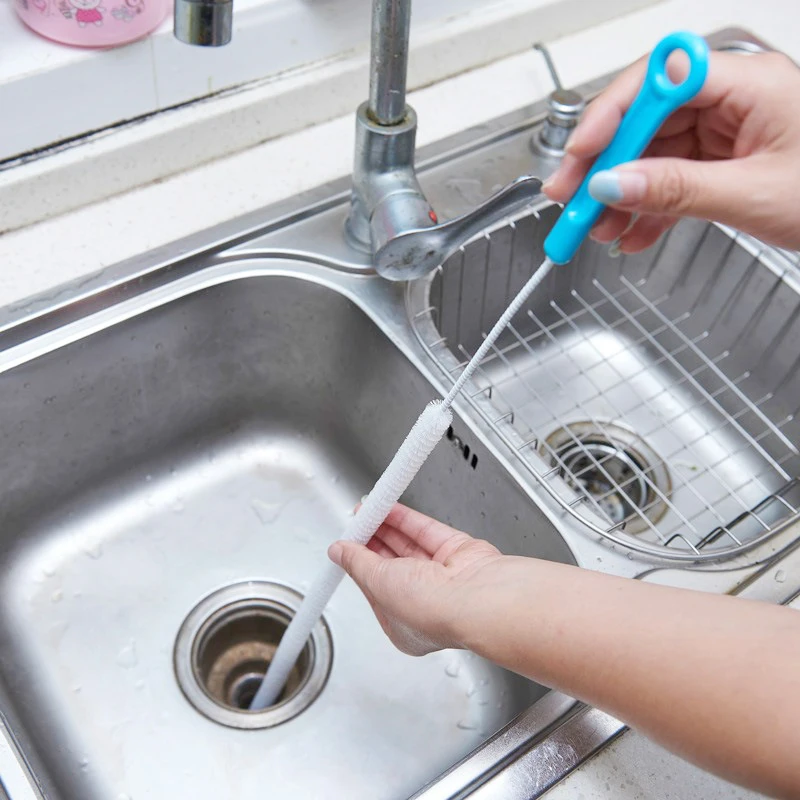
RELATED: The 10 Biggest Mistakes You Could Make at Your Kitchen Sink
Photo: istockphoto.com
Keep your kitchen sink draining properly.Once you’ve unclogged your drain, keep it open by following these guidelines.
- Leave water running the entire time the garbage disposal is in use, and for several seconds afterward, to thoroughly flush food scraps down the drain.
- Only feed half a cup of scraps into the garbage disposal at a time to avoid overloading its motor. If you don’t have a garbage disposal, toss food scraps into the trash or your compost pile.
- Once a week or so, dissolve buildup inside the pipes by pouring a half-cup of baking soda into the drain and then topping it with half a cup of white vinegar. The baking soda helps absorb odors, the mild acid of the vinegar helps dissolve buildup, and the foaming action of the two combined lifts away food particles and other slimy grunge. Once the foaming stops, flush the drain with hot water to further reduce buildup.

Whether you have a garbage disposal or not, the following items should go into your trash or compost pile, never into your kitchen drain:
- Coffee grounds, which tend to clump and eventually build up inside the pipes.
- Cooking fat or grease, which coat the inside of the drain and narrow the passageway.
- Starches such as rice, pasta, or potatoes in quantities more than a quarter-cup or so, which turn into a swollen, sticky mess inside the pipes.
- Stringy, fibrous foods such as celery, which can entangle garbage disposal blades.
- Bones, fruit pits, and eggshells, which are hard on a garbage disposal’s blades and don’t easily flush down the sink’s drainpipe.
- Any nonfood items, including paper, cigarette butts, paint, motor oil, hair, and kitty litter, none of which travel easily through plumbing lines.
Some jobs are better left to the pros
Get free, no-commitment estimates from licensed plumbers near you.
Find Pros Now
+Cleaning kitchen drains: tips and natural remedies
Kitchen drains clogged? Bad smell and water struggling to drain? How to clean pipes? All the tips and remedies to eliminate the unpleasant odor from cork. Natural products for cleaning kitchen drains.
When your kitchen drains are dirty and clogged, what you have in your house doesn't quite smell like roses. These dirty drains are really quite a problem that sooner or later we all have to face and decide not only for health but also for decoration: there is nothing worse than lunch or dinner in the kitchen where there is an unpleasant smell. nine0003
The solutions of to the market of are truly limitless, but almost always are based on chemicals that are effective but which could put your health at risk if inhaled and because these products mostly contain caustic soda.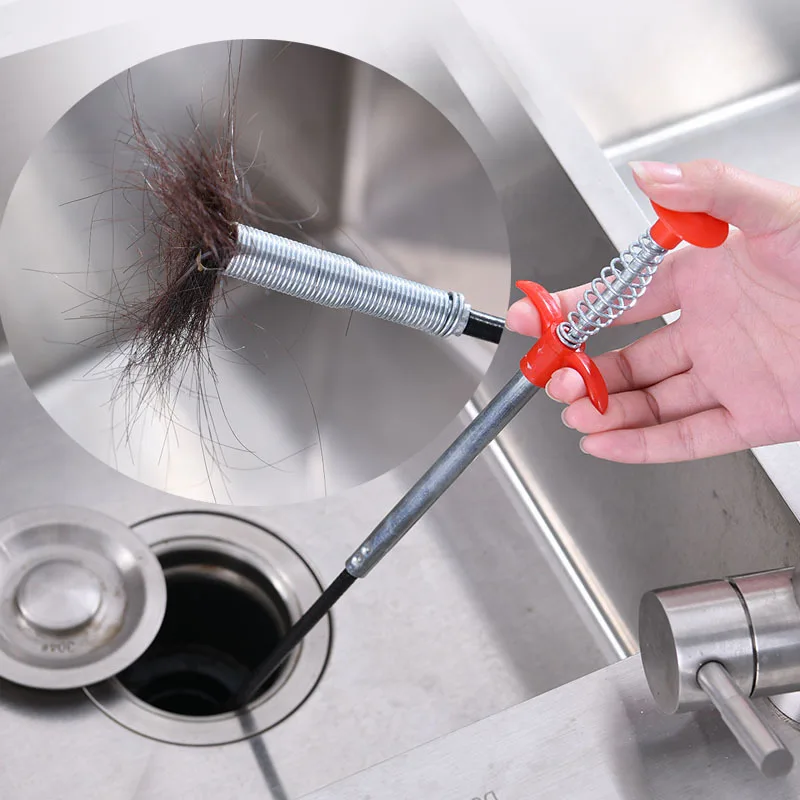
In addition to these products, which can be easily found in stores, there are natural alternatives, which we dispassionately recommend , which turn out to be equally effective, as well as harmless to you and the environment.
Here's how to clean your kitchen drain using products you're sure to have at home.
Natural Kitchen Drain Cleaners
We have selected for you what we consider to be the most effective natural remedies for clearing your kitchen wastewater clogging problem, preventing the problem and eliminating bad odours.
Vinegar, Baking Soda and Salt
The top natural cleaners for cleaning kitchen drains are definitely vinegar, baking soda and table salt .
These three ingredients, mixed with in a ratio of one cup of vinegar, one cup of baking soda and one salt, are effective for regular sewage cleaning and blockage prevention.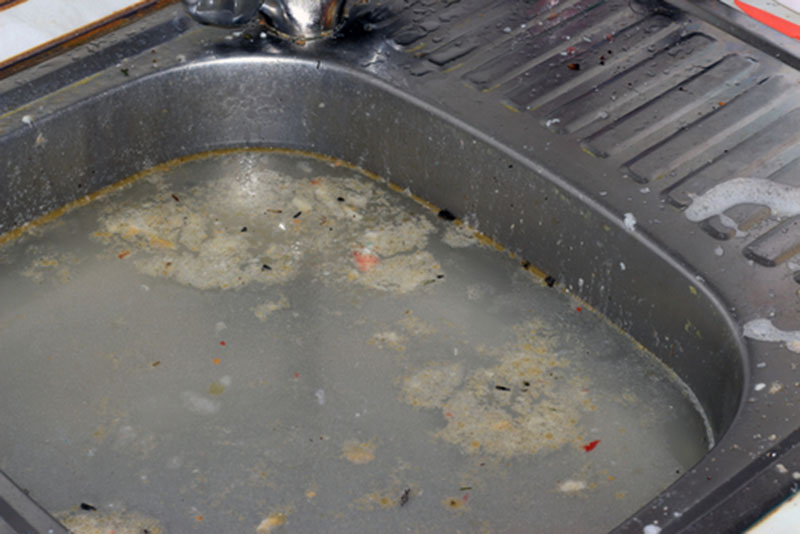
If, on the other hand, you encounter a clogged drain, proceed as follows:
- Pour a glass of baking soda
- One of salt
This solution is optimal how to eliminate in grease and vegetable oil that accumulates in discharges how to clean drains clogged with detergent.
Vinegar, salt and borax
The second remedy we offer is a mixture consisting of salt , vinegar and borax . Proceed as follows:
- Mix ¼ cup salt with ½ cup white vinegar and ¼ cup borax.
- Pour mix down the drain and finish with boiling water.
- If you want effect still more powerful you can be boiling in water with the addition of abbonante salt always given at the end of the operations listed above
In addition, thanks to this alternative you will be able to clean the kitchen drain in which very often remains of food, grease and detergents.
Baking soda, salt and lemon
Baking soda is a natural odor remover and is therefore the ideal solution for wastewater odor elimination. All you need:
- food soda
- Soil
- Lemon
Here are the steps to take:
- 9000 equal parts
- Pour mixture down the drain and add juice from lemon
- Finish with boiling water.
Salt only
To make drain cleaning even easier and more effective, use plenty of salt and boiling water.
All you need to do is heat in a glass of water and add three tablespoons of salt , pour the mixture down the drain and let it rest overnight.
How to prevent clogging drains
This is important however to avoid some things not to allow to obstruct from kitchen waste. For example, do not throw away leftovers oil or fat. Even though they are liquid, they harden, causing clogging and bad odour. In addition, in order to avoid the accumulation of residues from food, detergents or any other element that may cause interference, an effective method would be to use a filter in each drain. nine0003 However, it is important to frequently clean the drains to prevent odors and blockages. To free the clogged drain and clean it, probably the most classic method is to use the plunger with suction cup. Not only is it super effective, but it's also very easy to use because you just have to make sure the suction cup fits well on the edges of the drain and apply a little pressure and that's it. There are also very useful plungers on the market with pump which we recommend to purchase so you can use it at the first sign of clogging of the drain. As you can see, there is no need to resort to chemicals that are harmful to health and the environment to clean kitchen drains. In most cases the solution to the problem is right before our eyes . The use of natural, simple and effective methods can also be a turning point for greater respect for the environment. In addition to , you can always call the plumber , who will almost certainly perform the cleaning operation, with a mechanical sensor. To view the accompanying images, please view the gallery. nine0003 Ways to remove simple and complex blockages Prevention What to do with a blockage in the kitchen sink? We have collected all the existing ways to solve this problem. But in most cases, everything can be fixed on your own. When there is no strong congestion, and the water only lingers a little in the sink, improvised means or even simple boiling water from the tap are enough. This is the first thing you can do - turn on the hot tap for 10-20 minutes. The thin fatty layer on the walls should dissolve. If this does not work or is not possible, proceed to the next options. For plastic drains, the water temperature must not exceed 60°. In metal, you can pour boiling water from the kettle. nine0003 Instagram @ultimateplumbinginc Instagram @waterliberty In general, all methods can be divided into chemical and mechanical. They help to break through a very small cork and remove an unpleasant odor. There are three recipes. Citric acid can be used instead of soda. Remember that the plastic siphon should not be exposed to high temperatures. There are a lot of products sold in stores to remove traffic jams. They are dry, gel and liquid. Select the appropriate solvent based on the characteristics of the material to be cleaned and the degree of contamination. Some of them cannot be poured into plastic. This information is indicated on the packaging. nine0003 The most popular brands are Mole (may require several treatments and two bottles), Bagi Potkhan, Sanoks Pure Stock. They are sold in different forms, but more often in liquid form. Other names: Tiret Turbo, Sanfor, Selena, Chirton. Good reviews about Deboucher. The liquid does not damage fragile materials, breaks down fat and softens solid waste, works within a few hours and is economically consumed. With pothan granules, manufacturers advise to be especially careful and stay away when using them. The algorithm is simple: the required amount of product is poured or poured into the drain for an hour or overnight. During this time, you can not use the sink. After that, they wash off what is left. Instagram @ulyana_koronova Instagram @defrem.com.ua The following method is used alone or in addition to the two listed. But it's better to work together. Another item that is sure to be in every home. An ordinary glass can be used as a tool. True, this will only work for very minor contaminants. Pixabay Overflow opening to be closed Instagram @muzhnachas. This method can be called experimental. There is no certainty that it will work. To make it work, you need a powerful vacuum cleaner with a blowing function. The pipe must be wrapped with a rag, placed in the drain hole and the device turned on. According to the plan, the cork should collapse from the created pressure. nine0003 A kitchen sink can become so clogged that none of the previous methods will work. In this case, you can not do without a more complex procedure. Open a window or window - the smell during work can be very unpleasant. After that, treat with household chemicals to wash off the fat. nine0003 Instagram @tros_santeh Instagram @masterphc Sometimes this is the best way to fix a problem. It doesn't take any special skill to sort it all out. You will need a wrench, a bucket or basin, a rag, a screwdriver, a cork pusher, and a stain remover. Sometimes the siphon cannot be partially dismantled. Empty the drain
 nine0003
nine0003 Cleaning kitchen drains: conclusions
Kitchen Drainage Cleaning: Photos and Pictures
What to do if the kitchen sink is clogged: how to clean the clog with your own hands
All ways to remove the plug:
 It happens that it is difficult to fix the problem with these methods. This suggests that the pipes are clogged with debris and grease due to mechanical damage or improper installation of plumbing. In such a situation, you will need the help of a specialist. nine0003
It happens that it is difficult to fix the problem with these methods. This suggests that the pipes are clogged with debris and grease due to mechanical damage or improper installation of plumbing. In such a situation, you will need the help of a specialist. nine0003  First, we will talk about the first and start with folk advice. What if you need to act now, but there is no opportunity to buy a special tool? Use what is in almost every home.
First, we will talk about the first and start with folk advice. What if you need to act now, but there is no opportunity to buy a special tool? Use what is in almost every home. Soda, salt, vinegar

What to do if the problem cannot be solved? We tell you how to clean the blockage in the sink in the kitchen in this case. Household chemicals
 They have a very pungent smell. nine0003
They have a very pungent smell. nine0003 When working with household chemicals, follow the rules
Plunger
 You should not rely on it if a tight plug has formed in the drain, but small contaminants can be cleaned without problems. nine0003
You should not rely on it if a tight plug has formed in the drain, but small contaminants can be cleaned without problems. nine0003 So, what to do with the plunger if the sink in the kitchen is clogged
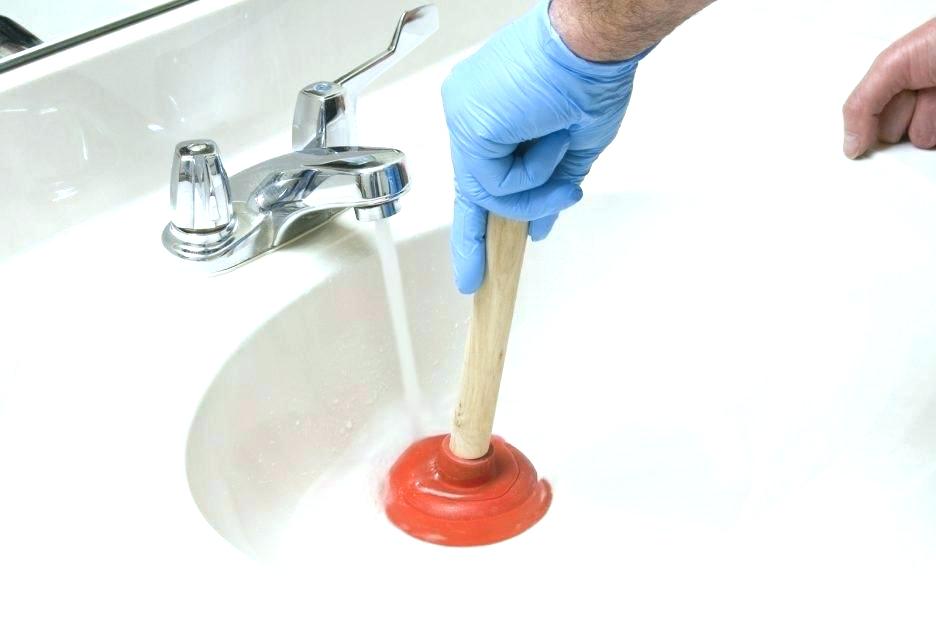 bytovyeuslugi
bytovyeuslugi Vacuum cleaner
Plumbing tools
 It deforms when turning, therefore it is considered an impractical and disposable tool.
It deforms when turning, therefore it is considered an impractical and disposable tool. How to use the cable
Structural Disassembly
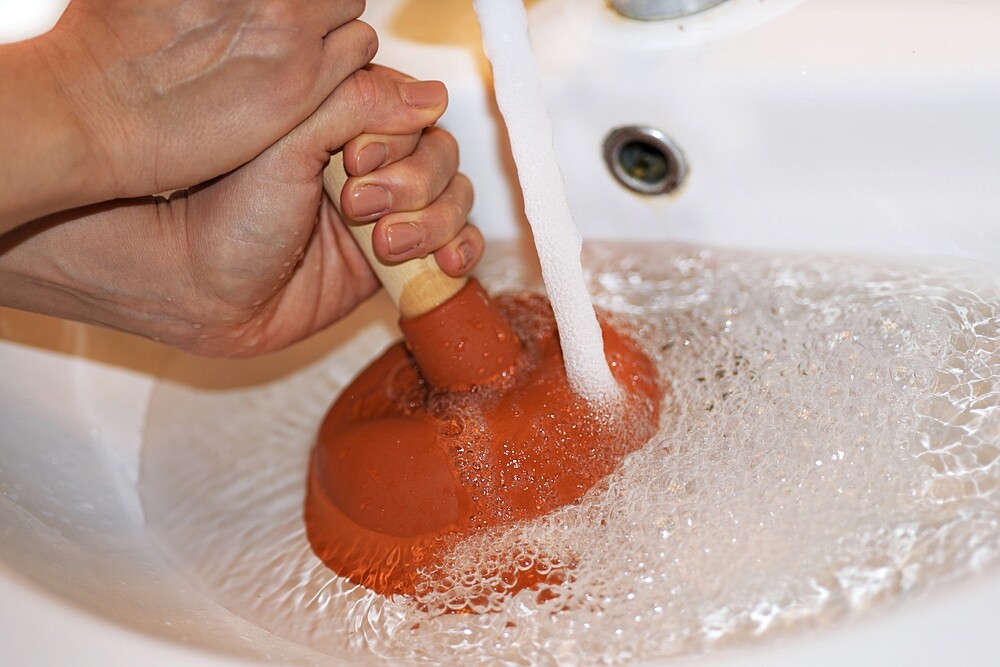 Debris can accumulate in the siphon, and it is cleaned only by separating it from the rest of the plumbing or after partial dismantling. The corrugated pipe also collects grease on its surface, making it difficult for the sewer to work properly. nine0003
Debris can accumulate in the siphon, and it is cleaned only by separating it from the rest of the plumbing or after partial dismantling. The corrugated pipe also collects grease on its surface, making it difficult for the sewer to work properly. nine0003 How to disassemble the structure
 In this case, it is removed completely by unscrewing the upper and lower fasteners.
In this case, it is removed completely by unscrewing the upper and lower fasteners.
Instagram @bronzastudio1
The sink can get clogged every month if some preventive measures are not taken. The simplest of them is to skip boiling water from a kettle or hot water from a tap every week for 15-20 minutes. So you dissolve the fat adhering to the walls of the pipe. If the problem occurs on a regular basis, you can pour household chemicals or soda with vinegar along with boiling water.
A strainer that prevents food waste from seeping down the drain is a must-have kitchen attribute. The siphon also needs a mesh to filter drains. Do not shake crumbs, tea leaves into the sink, do not pour greasy food. Sometimes you can find advice about installing a grinder for leftover food. In fact, it does not eliminate the possibility of blockage, since small particles still stick to the surface.